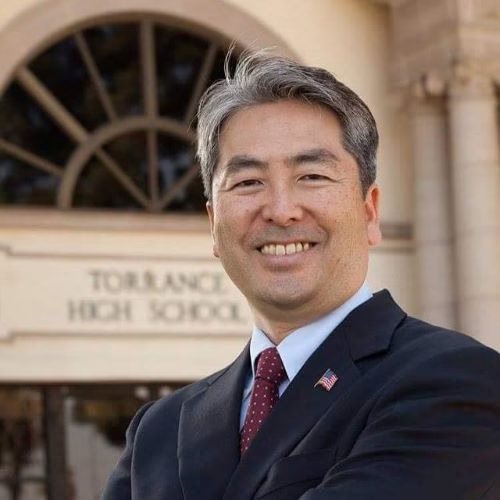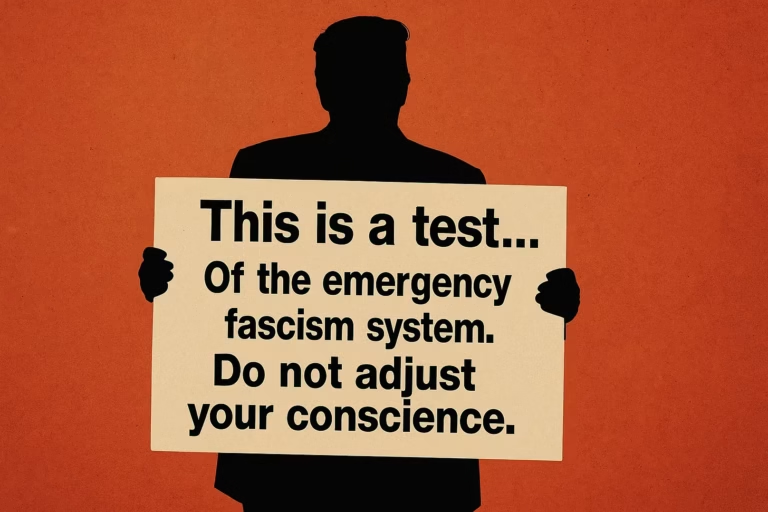Each escalation — from ICE kidnappings to threats against critics — is a measure of how much authoritarianism we’ll tolerate before we push back.
Trump’s threat to strip Rosie O’Donnell of her citizenship is a “test.”
Kids do it all the time. Throw a tantrum in the store demanding cookies and if the parents don’t remove them from the store right away, every visit will see the tantrums escalate. Testing the boundaries. When the test succeeds, the boundaries get moved and a new boundary gets tested, on and on until finally the child’s behavior is so egregious he’s stopped. Or he always gets away with everything and grows up to be Donald Trump.
We learn this early.
We’ve seen a series of these tests coming from the Trump administration, following the very specific and consistently repeated pattern that history tells us played out in the regimes of Mussolini, Hitler, Pinochet, Putin, Orbán, Erdoğon, el Sisi, and pretty much every other person who took over a democracy and then, step-by-step turned it into a dictatorship.
Trump started testing racism as a political weapon when he came down the elevator at Trump Tower and spoke about “Mexican murderers and rapists” in front of what media reports said was a crowd he’d hired for $50/person from a company that provides extras to movie and TV production companies.
While his initial goal was reportedly to get NBC to renew Apprentice and pay him more than Gwen Stefani, his racism test work out shockingly well; suddenly he was a serious contender for the party that had inherited the KKK vote when Democrats abandoned the South with the Civil Rights and Voting Rights acts in the 1960s.
Another test was whether the exaggerations, distortions, and outright lies that he and his family had used to hustle real estate could work in politics.
He quickly discovered that GOP base voters — after decades of having uncritically (slavishly, even) swallowed lies about trickle-down economics, “evil union bosses,” and the “importance of small government” — were more than happy to embrace or ignore, as the occasion demanded, his prevarications.
From there, Trump tested exactly how gullible his most fervent supporters — and the media that fed them a daily diet of very profitable outrage and hate — would buy into a lie so audacious, so in defiance of both the law and common sense, so outside the bounds of normal patriotism, that they could be whipped into a murderous frenzy and kill three police officers while trying to overthrow the government of the United States of America.
The nation and our press reacted as if he’d failed that test, but when he was able to cow enough senators to avoid being convicted in his impeachment trial, he knew he’d won.
Now he’s again testing how far he can go.
George Retes is a 25-year-old Hispanic natural-born American citizen and disabled Army veteran working as a security guard at a legal marijuana operation in California. When it was raided by ICE, he got in his car and tried to drive away to avoid getting in the middle of what he saw as trouble.
Masked agents chased him down, smashed the window of his car and pepper-sprayed him in the face, dragged him out of his car, and disappeared him.
Testing.
Will Democrats make a stink? Will the media make it more than a one-day story? Will any Republicans break rank and stand against his excesses? Was it even mentioned on any of the Sunday shows? How far can he go next time?
So far, Trump thinks he’s winning these tests. The outrages are coming so fast and furious that it’s becoming impossible to keep track of them, just like in Germany in 1933 and Chile in 1973.
Retes wasn’t the only US citizen who’s been arrested or detained by ICE; they’ve gone after a mayor, a member of Congress, and even assaulted a United States senator.
A 71-year-old grandmother was assaulted and handcuffed by masked agents. Axios documents others; as the CNN headline on the story about other US citizens being snatched notes: “‘We are not safe in America today:’ These American citizens say they were detained by ICE.”
Testing.
After years of hysteria on the billionaire-owned sewer of Fox “News” about our nation’s first Black president deploying “FEMA Camps” to detain white conservatives, Stephen Paddock killed 58 people and wounded hundreds of others in Las Vegas, ranting that FEMA Camps set up after Hurricane Katrina in 2005 were “a dry run for law enforcement and military to start kickin’ down doors and…confiscating guns.”
He murdered those innocent concert-goers, he said, to “wake up the American public and get them to arm themselves,” saying, “Sometimes sacrifices have to be made.”
Now those detention facilities conservatives feared has come into being, as Republicans in Congress just funded concentration camps like “Alligator Auschwitz” in multiple states across America.
Visiting congress members claim inmates are packed over 30 to a cage, with Florida Congresswoman Debbie Wasserman Schultz reporting her horror when she was shown that, “They get their drinking water, and they brush their teeth, where they poop, in the same unit.”
Testing.
We recently learned via CBS News from a whistleblower and now-released texts that Trump’s former lawyer and now-nominee for a lifetime federal judgeship, Emil Bove, then working in the Justice Department, advised the administration officials to tell federal courts “fuck you” when they ordered the return of Kilmar Abrego Garcia from an El Salvadoran hellhole concentration camp.
For months, the administration appears to have followed his obviously unconstitutional and illegal advice. Republicans want him on the federal bench anyway.
Testing.
Kilmar Abrego Garcia — who Trump official Erez Reuveni said had been deported “in error” — described how he was treated in that El Salvadoran concentration camp, telling his attorneys and the court that he’d been repeatedly beaten, then forced to kneel from 9 pm to 6 am “with guards striking anyone who fell from exhaustion.”
He had committed no crime and was deported in open violation of a federal judge who demanded the plane either not take off or return before landing in El Salvador. The Trump administration simply and contemptibly ignored the court’s order.
Testing.
In a White House visit, Trump told the El Salvadoran president, Nayib Bukele (who refers to himself as “the world’s coolest dictator”), that he wants to send American citizens to that country’s torture centers.
“The homegrowns are next, the homegrowns,” Trump said as the two men laughed. “You’ve got to build about five more places.”
Testing.
Meanwhile, ICE detention facilities are also holding US citizens like Andrea Velez, 32, who was snatched by masked agents during a raid in Los Angeles. As LA’s ABC News affiliate Channel 7 reported:
“Velez, a marketing designer and Cal Poly Pomona graduate, was arrested Tuesday morning after her family dropped her off at work. According to her attorneys, Velez’s sister and mother saw her being approached and grabbed by masked men with guns, so they called the Los Angeles Police Department to report a kidnapping.
“Police responded to the scene near Ninth and Spring streets and realized the kidnapping call was actually a federal immigration-enforcement operation.”
She’s out of the detention facility now, but on $5000 bond; ICE apparently has plans for her future.
Testing.
And now Trump is telling us he wants to strip a natural-born US citizen comedienne — who’s made jokes about him that pissed him off — of her US citizenship, “Because,” he says, “of the fact that Rosie O’Donnell is not in the best interests of our Great Country, I am giving serious consideration to taking away her Citizenship.”
If he can do it to Rosie — if there isn’t furious pushback (and so far, there isn’t) against this latest test — he can do it to me or you.
Hitler gained the chancellorship of Germany in January 1933; by July of that same year, a mere six months later, he’d revoked the citizenship of thousands for the crimes of being “socialists,” “communists,” Jews, or journalists and commentators who’d written or spoken ill of him. Trump appears to be just a bit behind him on that timeline.
Testing.
Trump wants NPR and PBS defunded as soon as possible, having issued an Executive Order to that effect, and has ordered his FCC to launch investigations that could strip major TV networks of their broadcast licenses if they continue to report on him and his activities in ways that offend him. He shut down the Voice Of America, ending America’s promotion of democracy across the world. He kicked the Associated Press out of the White House press pool.
Testing.
Trump has declared large strips of land along the southern border to be federalized territory and put the American military in charge of policing the area, in clear violation of the Posse Comitatus Act. That law prohibits the military from performing any sort of police function against civilians.
Testing.
When students spoke out on campus against Trump ally and longtime Kushner family friend Bibi Netanyahu’s murderous assault of Gaza and support for settlers stealing West Bank land from Palestinians, armed and masked federal agents began arresting those students, imprisoning them for their First Amendment-protected speech.
Then Trump went after their universities, bringing several to heel just as Orbán has in Hungary and Putin has in Russia.
Testing.
Yesterday, six Republicans on the Supreme Court said that Trump could wholesale mass-fire employees of the Department of Education, essentially shutting down an agency created and funded by Congress in defiance of the constitutional requirement that the president “shall take Care that the Laws be faithfully executed.” Justice Sotomayor wrote the dissent, flaming in extreme alarm at her colleagues:
“[This decision] hands the Executive the power to repeal statutes by firing all those necessary to carry them out. … The majority is either willfully blind to the implications of its ruling or naive, but either way the threat to our Constitution’s separation of powers is grave.”
Or maybe the six Republican justices on the Court are just scared? After all, judges across the country are being threatened, having pizzas delivered to their homes in the middle of the night by way of saying, “We know where you live.” This after U.S. District Judge Esther Salas’s son, Daniel Anderl, was fatally shot at their New Jersey home by a gunman disguised as a pizza delivery driver. Her husband was also shot, but survived.
A few months ago, after one of Trump’s rants against judges who rule against him, Judge Salas told the press:
“Hundreds of pizzas have been delivered to judges all over this country in the last few months. And in the last few weeks — judges’ children. And now Daniel’s name was being weaponized to bring fear to judges and their children. You’re saying to those judges — ‘You want to end up like Judge Salas? You want to end up like Judge Salas’ son?’”
Testing.
What’s next? Will we see Americans who’ve spoken poorly of Trump on social media arrested like both Orbán and Putin do?
Will more students end up on the ground or in jail?
Will more judges be charged with the crime of running their own courtrooms in ways Trump and ICE dislike?
More mayors arrested?
More Democratic Senators taken to the ground and handcuffed?
Will Americans start being disappeared in numbers that can’t be ignored? Deported to El Salvador and South Sudan?
Will journalists be destroyed by massive libel suits or imprisoned for what they write?
Will more judges bend to Trump’s will because they’re either terrified or, like Clarence Thomas and Sam Alito, have apparently become radicalized by Fox “News” or other rightwing propaganda outlets?
The way we all react to these tests will determine Trump’s and the GOP’s next steps. So, what do we do?
President Obama says Democrats need to “toughen up.” While true, it would have been nice to hear “tough” words of outrage, warning, and leadership from him and Kamala Harris over the past six months. And Bill Clinton and George W. Bush.
But now — as it was in South Korea when their president tried to end democracy there last year and people poured into the streets and forced the government to act — it’s apparently going to be pretty much exclusively up to us.
See you on June 17th — this Thursday — for some “good trouble.”












